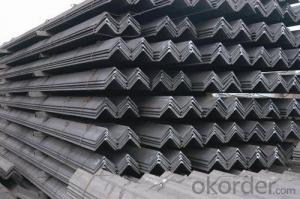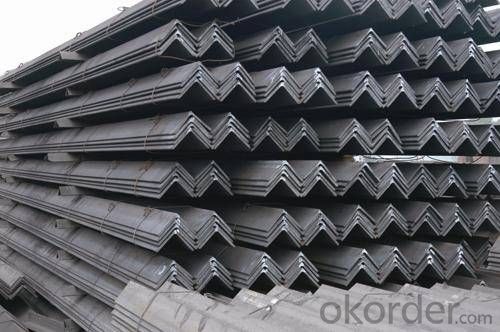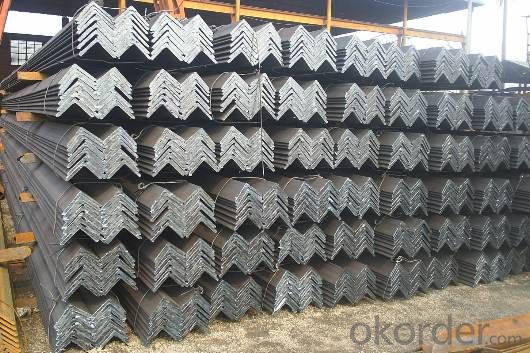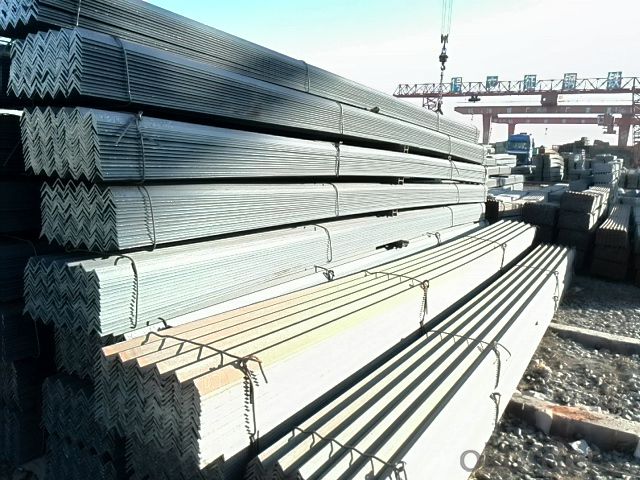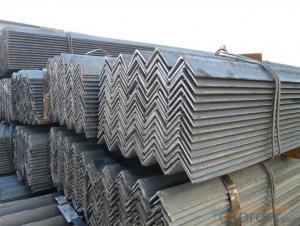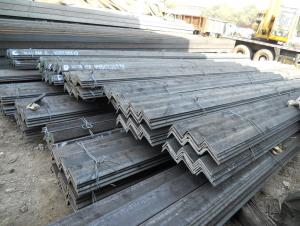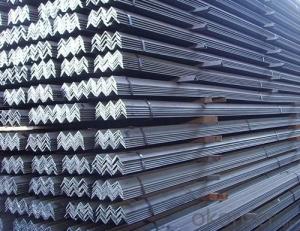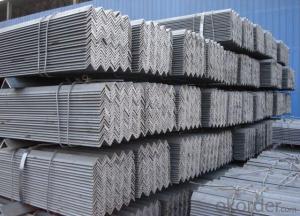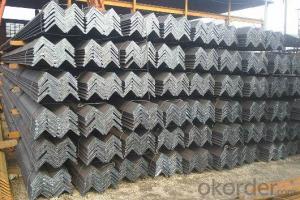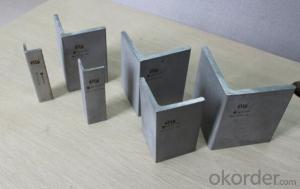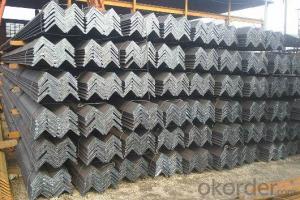Hot Rolled Steel Angle Bar with Best Price
- Loading Port:
- Tianjin
- Payment Terms:
- TT OR LC
- Min Order Qty:
- 25 m.t
- Supply Capability:
- 10000 m.t/month
OKorder Service Pledge
OKorder Financial Service
You Might Also Like
Specification
Okorder.com is a professional materials & equipment supplier & manufacturer, offers integrated one-stop services including real-time quoting and online cargo tracking. We are funded by CNBM Group, a Fortune 500 enterprise and the largest materials & equipment firm in China.
Product Applications:
According to the needs of different structures, Angle can compose to different force support component, and also can be the connections between components. It is widely used in various building structures and engineering structures such as roof beams, bridges, transmission towers, hoisting machinery and transport machinery, ships, industrial furnaces, reaction tower, container frame and warehouse etc.
Product Advantages:
OKorder's Steel Angles are durable, strong, and resist corrosion.
Main Product Features:
· Premium quality
· Prompt delivery & seaworthy packing (30-45 days after receiving deposit)
· Corrosion resistance
· Can be recycled and reused
· Mill test certification
· Professional Service
· Competitive pricing
Product Specifications:
1. Invoicing on theoretical weight or actual weight as customer request
2. Length: 6m, 9m, 12m as following table
3. Sizes

Sizes: 25mm-250mm | ||
a*t | ||
25*2.5-4.0 | 70*6.0-9.0 | 130*9.0-15 |
30*2.5-6.6 | 75*6.0-9.0 | 140*10-14 |
36*3.0-5.0 | 80*5.0-10 | 150*10-20 |
38*2.3-6.0 | 90*7.0-10 | 160*10-16 |
40*3.0-5.0 | 100*6.0-12 | 175*12-15 |
45*4.0-6.0 | 110*8.0-10 | 180*12-18 |
50*4.0-6.0 | 120*6.0-15 | 200*14-25 |
60*4.0-8.0 | 125*8.0-14 | 250*25 |
4.Material details:
Alloy No | Grade | Element (%) | |||||
C | Mn | S | P | Si | |||
Q235 | B | 0.12—0.20 | 0.3—0.7 | ≤0.045 | ≤0.045 | ≤0.3 | |
Alloy No | Grade | Yielding strength point( Mpa) | |||||
Thickness (mm) | |||||||
≤16 | >16--40 | >40--60 | >60--100 | ||||
≥ | |||||||
Q235 | B | 235 | 225 | 215 | 205 | ||
Alloy No | Grade | Tensile strength (Mpa) | Elongation after fracture (%) | ||||
Thickness (mm) | |||||||
≤16 | >16--40 | >40--60 | >60--100 | ||||
≥ | |||||||
Q235 | B | 375--500 | 26 | 25 | 24 | 23 | |
FAQ:
Q1: Why buy Materials & Equipment from OKorder.com?
A1: All products are carefully selected from China's most reliable manufacturing enterprises. Through its ISO certifications, OKorder.com adheres to the highest standards and a commitment to supply chain safety and customer satisfaction. We can guarantee the quality!
Q2: The products are invoicing on theoretical weight or on actual weight?
A2: We can do it in both manners, it’s according to buyer's requirement.
Q3: Can fit in the containers of 20fts for 6M long ?
A3: Yes, we can put them into the containers in the form sideling, in this way we can save the buyer much ocean freight.
Images:
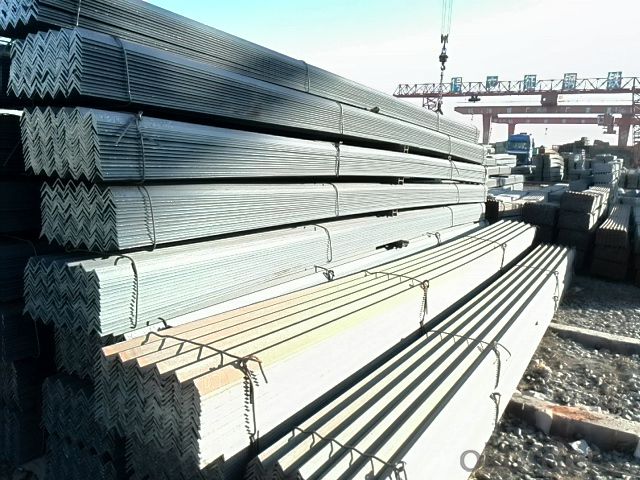
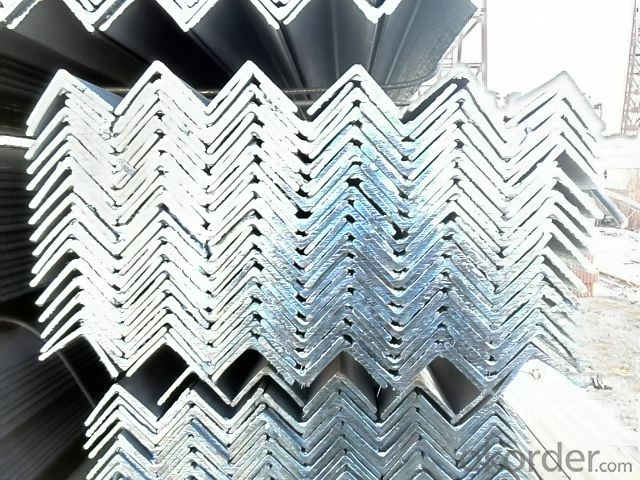
- Q: What is the standard tolerance for steel angles?
- Depending on the specific requirements and industry standards, the standard tolerance for steel angles can vary. Typically, the permissible variation in dimensions such as length, width, and thickness is used to specify the standard tolerance for steel angles. These tolerances guarantee that the angles meet the necessary specifications and are suitable for different applications. To determine the specific tolerance requirements for steel angles in a particular context, it is important to refer to relevant industry standards or specifications provided by organizations like ASTM or AISC.
- Q: Are steel angles fire resistant?
- Yes, steel angles are generally considered to be fire resistant. Steel is an inherently non-combustible material and has a high melting point, making it able to withstand high temperatures during a fire. Steel angles, which are L-shaped structural members, are commonly used in construction and engineering applications due to their strength and durability. In fire conditions, steel angles can maintain their structural integrity and resist deformation, which is crucial for the safety of a building or structure. However, it is important to note that the fire resistance of steel angles can be affected by factors such as the size and thickness of the angles, the type of fire protection measures applied, and the duration and intensity of the fire. Fire protection measures like fire-resistant coatings, fire barriers, and fireproofing materials can be used to enhance the fire resistance of steel angles and improve the overall fire safety of a structure.
- Q: How do you transport steel angles safely?
- Proper planning and adherence to specific guidelines are necessary for the safe transportation of steel angles. To ensure their safe transport, the following steps should be taken: 1. Secure the steel angles: Before transportation, it is important to securely fasten the steel angles. This can be achieved by using straps or chains to hold them firmly in place. Avoid any movement or shifting of the angles during transit by ensuring they are tightly secured. 2. Choose appropriate transportation equipment: Depending on the quantity and size of the steel angles, select suitable transportation equipment. Flatbed trucks or trailers with secure tie-down points are commonly used for this purpose. If needed, specialized equipment such as cranes or forklifts can be utilized for safe loading and unloading. 3. Safeguard the steel angles: To prevent damage during transit, it is crucial to protect the steel angles from potential hazards. This can be done by using adequate packaging materials like cardboard or wooden crates to cover and provide additional support. Additionally, consider using protective padding or blankets to prevent scratches or dents. 4. Ensure proper weight distribution: Maintaining proper weight distribution is essential for stability during transportation. Distribute the load evenly across the transportation equipment to avoid imbalance or tipping. If necessary, consult weight distribution guidelines or seek professional advice to ensure safe transportation. 5. Adhere to local regulations: Familiarize yourself with the transportation regulations and guidelines in your area. Ensure compliance with any specific requirements regarding load securing, maximum weight limits, or permits for oversized shipments. This will guarantee legal compliance and safe transportation. 6. Inspect and maintain the transportation equipment: Regularly inspect the transportation equipment for any signs of wear and tear. Check the condition of straps, chains, or tie-down points to ensure they are in good working condition. Proper maintenance of the equipment reduces the risk of accidents or incidents during transportation. 7. Plan the route and consider weather conditions: Before transporting the steel angles, carefully plan the route, taking into account any potential obstacles or road conditions that may affect safety. Be aware of height or weight restrictions on certain roads or bridges. Additionally, consider weather conditions such as heavy rain, snow, or strong winds, and adjust the transportation plan accordingly. By following these steps and taking necessary precautions, you can safely transport steel angles, minimizing the risk of damage, accidents, or injuries. Always prioritize safety and comply with applicable regulations for a successful transportation process.
- Q: Can steel angles be used for cable trays?
- Yes, steel angles can be used for cable trays. Steel angles provide structural support and stability, making them suitable for holding cable trays securely in place. They are commonly used in cable tray installations due to their strength and durability.
- Q: How do steel angles contribute to the resiliency of a structure?
- Steel angles contribute to the resiliency of a structure in several ways. Firstly, they provide additional structural support and stability by distributing the load across different members. Steel angles are often used as reinforcements or braces in construction projects, allowing for the transmission of forces and preventing excessive deflection or deformation. This helps to resist the impact of external forces such as wind, earthquakes, or heavy loads, enhancing the structure's overall resilience. Moreover, steel angles are highly durable and corrosion-resistant, which further adds to the resiliency of a structure. Steel, as a material, has exceptional strength and longevity, making it ideal for withstanding harsh environmental conditions and potential structural failures. This durability ensures that the structure can withstand the test of time, reducing the need for frequent repairs or replacements and improving its overall resilience. Additionally, steel angles offer flexibility in design and construction, allowing for efficient load transfer and optimized structural configurations. They can be easily customized and fabricated to meet specific project requirements, ensuring that the structure can be tailored to withstand various dynamic and static loads. This adaptability enhances the resiliency of the structure by enabling it to adapt to changing conditions or future modifications. Overall, steel angles play a crucial role in enhancing the resiliency of a structure by providing additional support, durability, and flexibility. Their ability to distribute loads, resist external forces, and withstand harsh conditions ensures that the structure can withstand unexpected events and maintain its integrity, making steel angles an essential component in resilient construction practices.
- Q: Can steel angles be used for bracing or reinforcement?
- Yes, steel angles can be used for bracing or reinforcement in various applications. They provide structural stability and support, commonly used in construction, engineering, and infrastructure projects. Steel angles offer strength and durability, making them suitable for reinforcing beams, columns, frames, and other structural elements.
- Q: How are steel angles used in construction?
- Steel angles have a wide range of applications in construction. They serve as important elements for providing structural support and reinforcement in buildings and other structures. Their primary function is to establish strong and stable connections between various components, including beams, columns, and trusses. The framework of a structure is typically formed using steel angles, which offer stability and strength. They can be utilized to create corners, support beams, and brace walls. Moreover, steel angles are commonly employed in the construction of lintels. These horizontal supports are placed above doors and windows to evenly distribute the weight of the structure and prevent any sagging. Apart from their structural purposes, steel angles can also contribute to the aesthetic appeal of a building. They can be used to create decorative edging or trim, enhancing the visual attractiveness of the structure. Additionally, steel angles can be employed in the construction of staircases, handrails, and other architectural features. In summary, steel angles are indispensable and versatile components in the field of construction. They fulfill crucial roles by providing structural support, reinforcement, and aesthetic elements. As a result, they ensure the durability, stability, and visual appeal of buildings and other structures.
- Q: What are the different types of steel angles connections for joists?
- Joists commonly employ several types of steel angle connections. These options include: 1. Welded Connection: The simplest and most prevalent connection involves directly welding the steel angles to the joists. This method provides a sturdy and inflexible connection, albeit requiring skilled labor and additional welding time. 2. Bolted Connection: This connection involves fastening the steel angles to the joists using bolts or screws. It allows for easier installation and disassembly if necessary. However, it may not be as robust as a welded connection and may necessitate periodic bolt tightening. 3. Gusset Plate Connection: A flat steel plate known as a gusset plate connects the steel angles to the joists. Typically, this plate is secured by welding or bolting to both the angles and the joists, enhancing the connection's strength and stability. 4. Clip Angle Connection: L-shaped brackets called clip angles attach to the joists and steel angles using bolts or screws. This method offers a straightforward and efficient means of connecting angles to the joists, with the added benefit of easy adjustment or replacement. 5. Shear Plate Connection: This connection type employs a thick steel plate with holes, known as a shear plate, to link the steel angles to the joists. Like the gusset plate connection, the shear plate is usually welded or bolted to both the angles and the joists, ensuring a robust and secure connection. The selection of a particular steel angle connection method depends on factors such as load requirements, installation ease, and cost considerations, as each option presents its own advantages and disadvantages.
- Q: What is the maximum allowable torsional stress for a steel angle?
- The maximum allowable torsional stress for a steel angle depends on several factors, including the specific grade of steel, the dimensions and shape of the angle, and the intended application. Steel angles are commonly used in structural applications, such as supporting beams and frames, and they are designed to withstand various types of stresses, including torsional stress. To determine the maximum allowable torsional stress for a steel angle, engineers typically refer to industry standards and codes, such as the American Institute of Steel Construction (AISC) Manual or the European standard EN 10056. These standards provide guidelines and formulas for calculating the maximum allowable torsional stress based on the properties of the steel angle, such as the cross-sectional area, moment of inertia, and modulus of elasticity. It is important to note that the maximum allowable torsional stress is usually specified as a percentage of the yield strength or ultimate tensile strength of the steel. This ensures that the angle can safely withstand torsional loads without undergoing permanent deformation or failure. In practical applications, engineers and designers must carefully analyze the specific requirements and loading conditions to determine the appropriate maximum allowable torsional stress for a steel angle. They consider factors such as the magnitude and direction of the applied torque, the angle's orientation, and any additional loads or constraints that may be present. Ultimately, the maximum allowable torsional stress for a steel angle is a critical parameter in ensuring the structural integrity and safety of a given design. Proper consideration of the steel's properties, industry standards, and specific application requirements is essential for making accurate calculations and selecting an appropriate steel angle that can effectively resist torsional stress.
- Q: How do steel angles contribute to the overall energy efficiency of a building?
- Steel angles contribute to the overall energy efficiency of a building in several ways. Firstly, steel angles are commonly used in the construction of building frames and structures, providing the necessary support and stability. By using steel angles instead of other materials, such as wood or concrete, the building can be constructed with fewer materials and therefore reduce the overall energy consumption during the construction phase. Moreover, steel angles are known for their strength and durability, which allows for longer spans and fewer support columns. This not only maximizes the usable space within the building but also reduces the need for additional heating or cooling systems. By minimizing the number of partitions and obstructions, steel angles enable better airflow and natural lighting, thus reducing the energy required for artificial lighting and ventilation. Additionally, steel angles can be used as a thermal barrier, providing insulation and reducing heat transfer. This helps to maintain a comfortable indoor temperature throughout the year, reducing the reliance on heating and cooling systems and consequently saving energy. Furthermore, steel angles have a high fire resistance, making them a safe choice for building construction. This reduces the need for fireproofing materials and systems, leading to energy savings both during construction and throughout the building's lifespan. Lastly, steel is a highly recyclable material, and steel angles can be recycled at the end of a building's life cycle. By incorporating recycled steel angles into new construction projects, the overall energy consumption and environmental impact can be further reduced. In summary, steel angles contribute to the overall energy efficiency of a building by reducing the amount of materials required during construction, optimizing space utilization, enhancing natural lighting and ventilation, providing thermal insulation, ensuring fire safety, and promoting the use of recyclable materials.
Send your message to us
Hot Rolled Steel Angle Bar with Best Price
- Loading Port:
- Tianjin
- Payment Terms:
- TT OR LC
- Min Order Qty:
- 25 m.t
- Supply Capability:
- 10000 m.t/month
OKorder Service Pledge
OKorder Financial Service
Similar products
Hot products
Hot Searches
Related keywords
